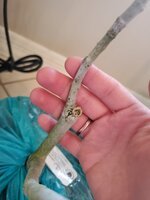GilaMonster
Well-known member
Judt got this yellow lebanese, was planning to container grow, fig has a V shape, on this half you can see where it was trimmed previously and thr wood has decayed, will this cause the tree to rot? Should I cut everything off from the point just below that hole? Should I fill it in with something?
Thanks for advice everyone

Thanks for advice everyone








